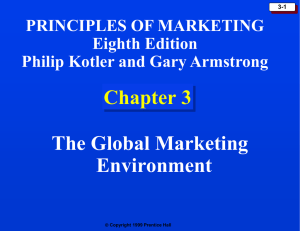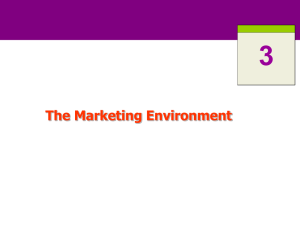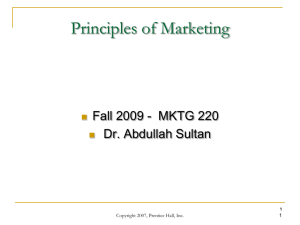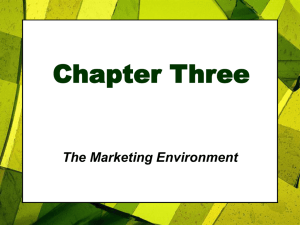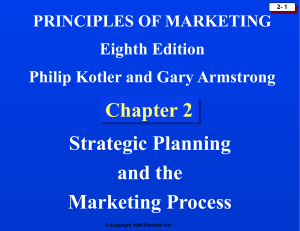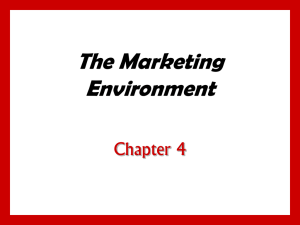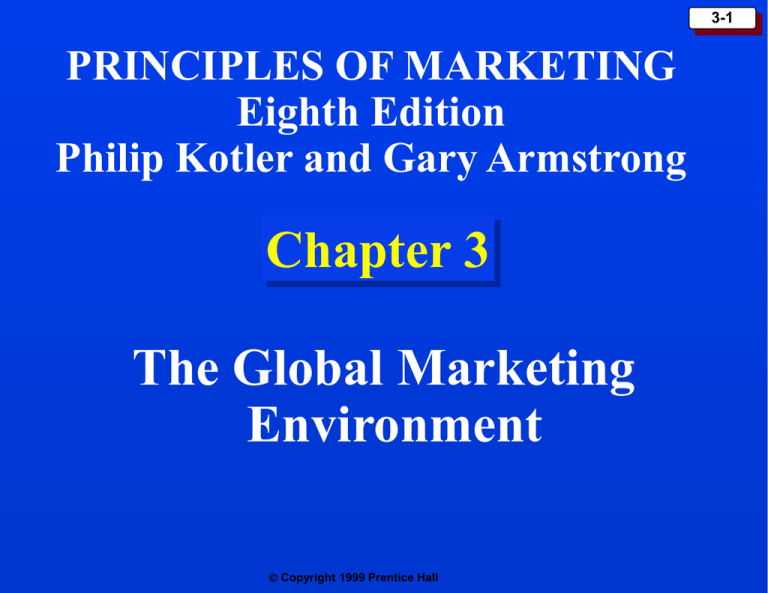
3-1
PRINCIPLES OF MARKETING
Eighth Edition
Philip Kotler and Gary Armstrong
Chapter 3
The Global Marketing
Environment
Copyright 1999 Prentice Hall
Marketing Environment
3-2
• All the actors and forces influencing the
company’s ability to transact business
effectively with it’s target market.
• Includes:
–Microenvironment - forces close to the
company that affect its ability to serve its
customers.
–Macroenvironment - larger societal forces
that affect the whole microenvironment.
Copyright 1999 Prentice Hall
The Marketing Environment
3-3
Demographic
Company
Economic
Cultural
Publics
Political
Company
Competitors
Suppliers
Customers
Intermediaries
Technological
Copyright 1999 Prentice Hall
Natural
3-4
The Microenvironment
Company
Publics
Forces Affecting a
Company’s Ability to
Serve
Customers
Competitors
Suppliers
Intermediaries
Customers
Copyright 1999 Prentice Hall
The Company’s
Microenvironment
3-5
• Company’s Internal Environment- functional
areas such as top management, finance, and
manufacturing, etc.
• Suppliers - provide the resources needed to
produce goods and services.
• Marketing Intermediaries - help the company
to promote, sell, and distribute its goods to
final buyers.
Copyright 1999 Prentice Hall
The Company’s
Microenvironment
• Customers - five types of markets that
purchase a company’s goods and
services.
• Competitors - those who serve a target
market with similar products and
services.
• Publics - any group that perceives itself
having an interest in a company’s ability
to achieve its objectives.
Copyright 1999 Prentice Hall
3-6
Customer Markets
International
Markets
3-7
Consumer
Markets
Company
Government
Markets
Business
Markets
Reseller
Markets
Copyright 1999 Prentice Hall
The Macroenvironment
3-8
Demographic
Cultural
Forces that Shape
Opportunities
and Pose Threats
to a Company
Political
Economic
Natural
Technological
Copyright 1999 Prentice Hall
The Company’s
Macroenvironment
• Demographic - monitors population in
terms of age, sex, race, occupation,
location and other statistics.
• Economic - factors that affect consumer
buying power and patterns.
• Natural - natural resources needed as
inputs by marketers or that are affected
by marketing activities.
Copyright 1999 Prentice Hall
3-9
Key U.S. Demographic Trends
Changing Age Structure
Population is getting older
Changing Family Structure
Marrying later, fewer children,
working women, and nonfamily households
Geographic Shifts
Moving to the Sunbelt and suburbs (MSA’s)
Increased Education
Increased college attendance
and white-collar workers
Growing Ethnic and Racial Diversity
73% Caucasian, 12% African-American,
10% Hispanic & 3.4% Asian
Copyright 1999 Prentice Hall
3-10
Economic Environment
Economic
Development
Key
Economic
Concerns for
Marketers
Changes
in Consumer
Spending
Patterns
Copyright 1999 Prentice Hall
3-11
Changes
in Income
Natural Environment
3-12
More Government
Intervention
Higher Pollution
Levels
Factors
Affecting
the
Natural
Environment
Increased Costs
of Energy
Copyright 1999 Prentice Hall
Shortages of
Raw Material
The Company’s
Macroenvironment
• Technological - forces that create new
product and market opportunities.
• Political - laws, agencies and groups
that influence or limit marketing
actions.
• Cultural - forces that affect a society’s
basic values, perceptions, preferences,
and behaviors.
Copyright 1999 Prentice Hall
3-13
Technological Environment
Rapid Pace of
Change
High R & D
Budgets
Issues in the Technological
Environment
Focus on Minor
Improvements
Copyright 1999 Prentice Hall
Increased
Regulation
3-14
Political Environment
Increased
Legislation
Key
Trends in the
Political
Environment
Greater
Concern for
Ethics
Copyright 1999 Prentice Hall
3-15
Changing
Enforcement
Cultural Environment
3-16
Of
Oneself
Of
the Universe
Of
Nature
Of
Others
Views
That Express
Of
Values
Organizations
Of
Society
Copyright 1999 Prentice Hall
Responding to the
Marketing Environment
• Environmental Management Perspective
–Taking a proactive approach to
managing the microenvironment and
the macroenvironment to affect
changes that are favorable for the
company. How? Hire lobbyists , run
“advertorials”, file law suits and
complaints, and form agreements.
Copyright 1999 Prentice Hall
3-17

